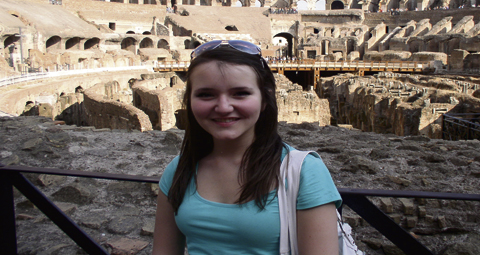February 3 | ![]() 0 COMMENTS
0 COMMENTS ![]() print
print

History and holiness are found at Rome’s heart
— Fresh from a visit to one of the world’s most historic cities, Catholic student Rachel Docherty gives us an insight into Italy’s capital
Landing in Rome, I could tell it was going to be very different from Scotland, in terms of the weather, beauty and religion. Rome has been defined as the eternal city and such a name perfectly sums up the age-old and everlasting importance of the place.
My first experience of Rome was remarkable and throughout my stay it was never dull. My friends and I found each of the religious buildings—with their various characteristics—fascinating and yet more was to be discovered by us: the Vatican City, the Colosseum, the Catacombs of St Callixtous and the Trevi Fountain.
The cold of the catacombs
The one memory of Rome that I remember very clearly due to the unusual experience was the visit to the Catacombs of St Callixtous. The weather that day was extremely warm and standing in the sunshine was very unpleasant. Instead, everybody was fighting to stand in the shade and fill up our water bottles. But, in contrast to the weather, down in the catacombs it was very cold.
The first glimpse of the tour leader revealed that she was covered, head to toe, in thick clothes—woolly hat, woolly gloves, woolly jumper and big boots. This was ridiculous I thought, but I then discovered that it was a very wise idea, given that, less than five minutes into the visit, I, too, was freezing. It was dark and damp and the smell of strong earth and dust pervaded my senses. However, the history of the catacombs was stimulating and the story of a young girl, St Cecilia, caught everyone’s attention.
St Cecilia refused to worship the Roman Gods, as she believed in only one God—Our Holy Father. She was to die of suffocation but survived by singing a song. Thus she was to be killed by a knife and in spite of this, she survived yet again but only to summon enough strength to extend the thumb and two fingers on her right hand and a single extended finger on the left hand—representing the Father, Son, Holy Spirit and the one God. Nonetheless, the whole point of this legend was that she was brave enough to talk of God and died spreading her belief in God. It was emotional and traumatic to listen to but also very inspiring to realise that St Cecilia will never be forgotten.
After, in one pupil’s opinion, ‘a scary walk’ around the burial place, we were set to have a private Mass for our school in the catacombs, to pray for those buried within the catacombs and those who are in our lives, as we were so far from home.
Magnificent Colosseum
As I caught my first sight of the magnificent Colosseum it made me feel like a tiny insect. The scene of Ancient Rome’s most lavish and gory spectacles, the Colosseum is the world’s best-known amphitheatre. Audiences, numbering up to 50,000 people, would be fascinated by gladiatorial contests such as games, dramas, battle re-enactments, and executions.
Named after the nearby colossal statue of Nero, which was believed to have magical powers, the Colosseum was designed as a massive entertainment centre. It primarily hosted spectacles with gladiators—professional swordsmen who would battle to death with condemned, freedom-seeking prisoners and other gladiators for honour and possible freedom after three years of slavery. The Colosseum is considered an architectural and engineering wonder and is proof of both the grandeur and cruelty of the Roman Empire.
An audience with the Pope
After visiting the Vatican City, what can I say? It was astonishing. We climbed the 330 steps to the top of the dome, visited the museums and saw Pope Benedict XVI at his public audience.
It was no surprise that, as the Pope acknowledged each school present and which country they were from, the St Ninian’s group shouted and stamped our feet the loudest. I have never seen my RE teachers so happy.
In addition to the natural beauty of its gardens, the Vatican City is rich in monuments and precious works of art. My favourite was the Feast of Transfiguration, and a certain quote runs through my mind every time I think of the painting: “And a cloud came, covering them in shadow: and there came a voice from the cloud, ‘This is my Son, the Beloved. Listen to Him.’” (Mark 9:7)
Climbing the 330 steps to the top of the dome of St Peter’s Basilica was exhausting but well worth the effort. Spiral staircases dominate the majority of the climb but there are also parts where you have to walk on a slight incline as the walls lean to form the dome shape. There are also very straight, steep parts where there is a rope to help keep your balance as you climb, until, finally, you emerge, (out of breath albeit) to the top and the stunning views of Rome that meet you from every side. There are no words to describe seeing the whole city across the horizon. It was like being on top of the world looking down from the heavens. The trip to the Vatican City, with its museums, the Papal audience, the beautiful waterfalls and the dome, was a great day.
Fountain of knowledge
Rome’s Trevi fountain, where many tourists gather throughout the day, is the busiest place I have ever been to. The Fontana di Trevi or Trevi Fountain is the most famous and arguably the most beautiful fountain in all of Rome.
This impressive monument dominates the small Trevi Square located in the Quirinale district. I favour this place the most because of my love for Greek mythology, which I study. The central figure of the fountain, in front of a large niche, is Neptune, god of the sea. He is brother to Zeus, god of sky, and Hades, god of the underworld. Neptune is riding a chariot in the shape of a shell, pulled by two sea horses. A Triton guides each sea horse. One of the horses is calm and obedient, the other one restive. They symbolise the fluctuating moods of the sea. On the left hand side of Neptune is a statue representing abundance, the statue on the right represents good health. Above the sculptures are bas-reliefs; one of them showing Agrippa, and the general who built the channel that carries water to the fountain.
The water in the Trevi Fountain was beautiful and sparkly. It was as cold as ice, and I couldn’t look at the water without thinking of jumping in! What interests me about the fountain is the tradition, or time-honoured custom, of throwing a penny over your shoulder to either make a wish of your heart’s desire or to guarantee a return to the splendid city.
Fresh faith outlook
Looking back on my trip as a whole, I can say that Rome helped encourage me both in terms of hope and faith. It was enjoyable to see religion and culture from a different perspective. My faith in God is always there; it was good to talk about our beliefs together and, as I move on to finding out my place in the world, it was good to stop and encourage our Faith in what we all believe in.
Rome was a great place to visit, not just for the enchanting sights or tourist entertainments but also for the holiness of the place. There are so many churches, each with its own history and so many sites where religion was of great importance. It is with regret that I have not yet seen all of these religious aspects owing to the short time I had. But, maybe, one day I will return, considering that I made a wish, and finally finish off my tour of Rome











